We all know we’re supposed to check our car before we set off on a long journey. But what does that actually involve? We’ve got all the answers in this guide!
These checks can be done by anyone at any time and will not need any special equipment or prior knowledge.
What Checks Should Be Made Before a Long Car Journey?
We've rounded up our top ten car checks to complete before a long trip below which are a guideline for what you should be checking but there may be other items that you want to check depending on your individual vehicle and trip needs.
1. Visually Inspect the Exterior
The first thing to do is walk around your car looking at its exterior condition. There are a few things you’ll want to look at:
- Glass
- Mirrors
- Fuel cap
- Tyres
You will want to check that there are no chips or cracks in any of the glass, which includes front and rear windscreens and side windows. If there are any chips or cracks then we recommend getting these repaired as quickly as possible to avoid them becoming larger and more expensive problems, however you can still drive with them provided that it does not block the driver’s field of vision or is dangerous for any passenger.
A chip or crack 10 mm or larger over the 290 mm area directly in front of the driver and one over 40 mm on the rest of the windscreen is so serious that your car will fail its MOT if tested with this damage.
As well as checking for any chips or cracks you should also make sure there is nothing on the glass work that will impair your vision, such as dirt or marks. If you do notice anything that could reduce your vision, then you should clean this off.
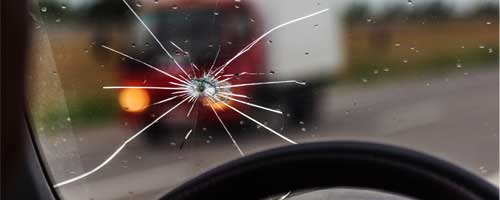
When checking for any dirt or marks that will restrict your vision you will also want to check your wing mirrors. You should also check they are damage free and when inside the vehicle have been adjusted to the best position for you.
Another quick check you’ll want to make is ensuring that your fuel cap is fully closed, especially if you are setting off after filling up for the journey.
2. Check Your Tyres
One of the most important parts of your vehicle is its tyres, which means this is a critical check you should make before going on a long journey.
There are three elements that you should check:
- Appearance
- Tread
- Pressure
The appearance and tread you can check as part of your visual inspection of the exterior but you will need to use a pressure gauge to check the tyre pressure.
When looking at your tyres you want to check for any cracks and bulges to them, as this indicates areas of wear and might cause you a larger problem if you drive on them.
Cracks can occur when a tyre is older or has been exposed to a lot of direct sunlight and you can drive with smaller crack without it being a problem. Bulges happen when the sidewall of the tyre is weakened, which can be caused by driving over potholes or knocking against kerbs repeatedly.
We recommend getting your tyres looked at by a professional and repaired or replaced where necessary if you are at all concerned about the condition and any damage you notice to them before going on any long trips.
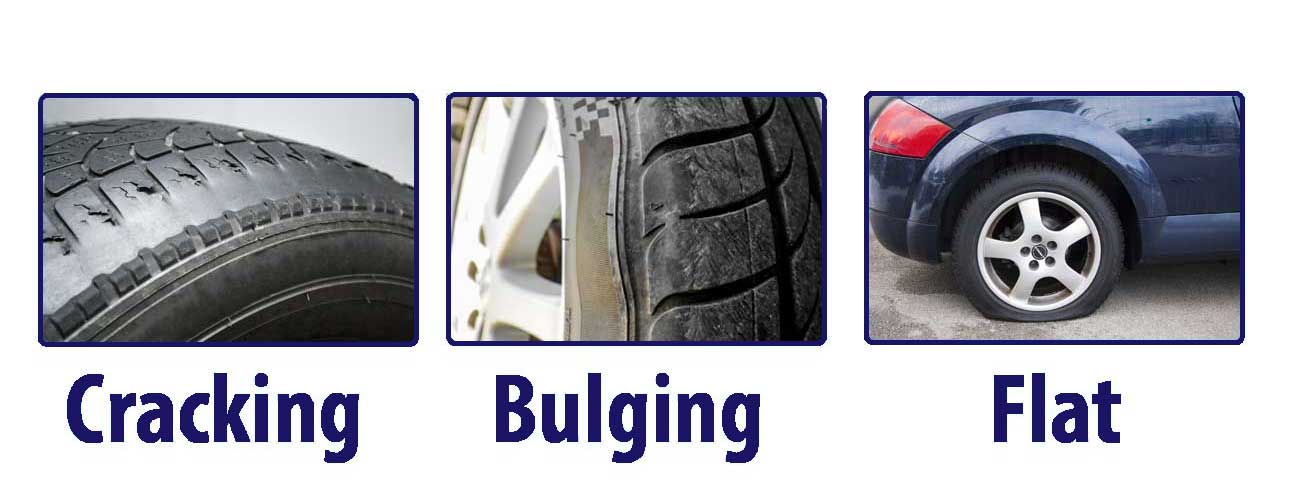
The tyre tread is an easy check, and you can effectively check this with a ruler or 20 pence piece.
The tread on your tyres is legally required to be 1.6 mm or more in the central three-quarters of the tyre around the entire circumference so as soon as it goes below this you should get the tyre replaced.
Tyres experience different levels of wear and so you might find that some of your tyres need replacing more frequently than others. This is common and nothing to worry about, unless you are going through tyres at a particularly rapid rate.
To use a 20 pence to check the tyre simply put it into your tread and as long as it covers the outer edge of the border on that side your tread is fine.
To check the tyre pressure you’ll need to use a tyre pressure gauge. You do not need to have one of these at home, and can easily use the gauge at a garage, as this will also allow you to top up where necessary.
You might need to consult the vehicle manual or the manufacturer’s website for the correct pressure for your tyres, or some cars come with this information on the inside of one of the front door sills.
It’s important to be aware that some vehicles will have different pressures for the front and rear tyres.
There’s a detailed breakdown with step by step instructions on how to check your tyre pressure here.
If your vehicle is supplied with a spare wheel, then you’ll also want to check the tyre on this in case you end up needing it on your trip.
Correct tyre pressure is essential to ensure vehicle safety, gives a more comfortable ride and improves fuel economy.
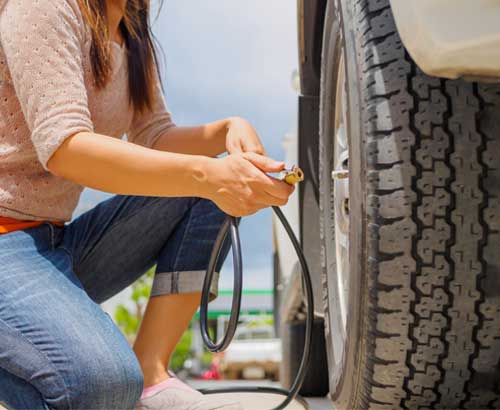
3. Clean Your Screen
We mentioned above clean windscreens front and rear are important so that you have a clear view of the road ahead and other traffic around you.
As well as clearing them before setting off you should check the level of screen wash you have for the journey. To do this you need to open the bonnet, and secure this with the support arm if your vehicle has one, to prevent it from falling and causing injury.
Before opening the bonnet and completing any fluid checks you should make sure that you are parked on level ground to ensure accurate readings. You should also complete these checks on a cold engine as hot components could cause serious injury.
To check the screen wash level you will just need to have a look at the container to make sure that it is not too low. Most containers will be semi-transparent so that you can see the level without having to open it.
If you’re unsure where the screen wash is located you will be able to find out from the vehicle manual.
If you need to fill up, then you will need to unscrew the lid and add the fluid. We recommend checking the fluid you are using to ensure that it does not need diluting with water.
Even if it is nice weather at the start of your journey you may encounter muddy roads, poor weather or bird lime that requires cleaning on the way.
While we’re on your windscreen you should also check the rubber on your wipers. If the car is in regular use, then you should already know whether these need replacing but it’s always worth checking again before you set off.
4. Check Your Oil Levels
Another fluid you’ll want to check is the oil.
Again, it’s important to remember that you should check this when the engine is cool. Which means giving it some time after driving to cool down.
To check the oil level you will need to remove the dipstick. You should be able to easily locate this as it will be either a bright yellow or orange pull ring.
Once you’ve pulled out the dipstick you should then wipe it clean so that no residual oil remains and could provide a false level.
When the dipstick is clean you can then return it to the oil tank to take a reading. Your level should be between the minimum and maximum level markers on the dipstick. If your dipstick does not have these markers then it should be at a decent level on the dipstick.
If you need to top up the oil then there will be a separate cap that you can open to top up.
Please note that there are different kinds of oil that you can use and you should always check the manufacturer’s guidelines to find the correct kind for your vehicle.
Most modern cars will notify you when the oil level is too low, but we recommend checking it yourself before setting off on a long journey so that you do not run low in an inconvenient place.
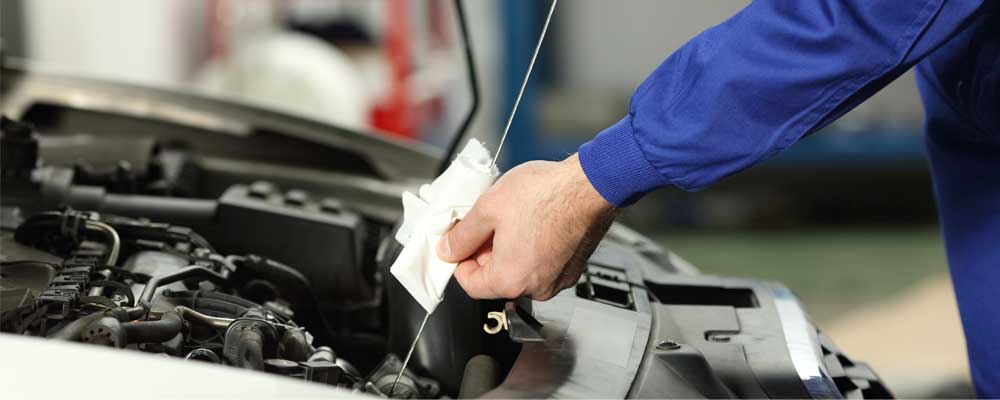
5. Check The Engine Coolant
The third fluid we advise checking is the engine coolant, sometimes known as antifreeze. It is essential no matter what the weather is as it protects your engine from extremely cold temperatures and its high boiling temperature removes excess heat from the engine preventing it from overheating.
The coolant tank will be semi-transparent like the screen wash container, and so you will be able to see the level without opening the tank. There will also be minimum and maximum lines on the side that you can use to make sure the fluid is at an appropriate level.
If you need to top it up then you should check the manufacturers guideline to see what coolant your engine can accept.
It is especially important that this check and top up is done when the engine is cold, and we recommend leaving the vehicle for at least eight hours since it was last used before opening the coolant tank. This is because the coolant can get incredibly hot and with the pressure in the tank opening it when not cool can cause serious injury.
Again some vehicles will let you know when this drops too low with a coolant warning light, or check engine light. Even if your car has this function we advise checking before taking any long trips as if it comes on whilst on the road you will need to pause for some time to wait for the engine and coolant to cool before topping up.
6. Make Sure Your Lights are Working
Before setting off on any long journey you should check that all of your lights are working. This includes the headlights, high beams, rear lights, fog lights, brake lights, indicators and reversing light.
To complete these checks you can ask a friend, family member or neighbour to help or use a reflective surface like a garage door or window to complete the checks on your own.
To check your indicators are working turn on your hazard warning lights and walk around the vehicle making sure they are all flashing.
To check your headlights and high beams face the reflective surface, or your helpful companion, and turn them on. You can also check a front fog light, if your vehicle has one, by applying this now.
Then you should turn around and reverse up to the reflective surface to check the brake lights, rear lights, including the rear fog light, and the reversing light.
If any of the lights aren’t working then you should replace them before setting off on your journey.
7. Test Your Brakes
You should also check your brakes are working correctly before setting off.
There are two checks to complete. The first is to press down on the brake pedal before starting the engine, it should feel spongy and not slack at all.
Then turn the engine on and conduct the second test. In a safe place you should apply the brakes firmly when driving. The vehicle should stop promptly and not pull to one side. This might also be known as an emergency stop.
8. Check the Electrics
Before you head off you should check that your essential electric systems are working. These will not always be flagged on the dashboard by your car if there is a problem and so you will need to check these yourself.
There are three main systems we recommend checking – the electronic windows, the air conditioning / heating system and the power steering.
Testing the windows is easy, simply turn the engine on and try opening and closing them all to ensure they are fully functioning. If you have young children or pets that will be in the rear and your vehicle has this feature then we also recommend using child locks to prevent the rear windows and doors from being opened by them accidently. Again, it would be wise to check these are on and working correctly before setting off.
Similarly, to test the air conditioning system we advise turning this on while stationary. You can then test the temperature range, power and direction of the vents and set them to comfort settings for you and your passengers.
To check the power steering you will need to turn the engine off, apply gentle pressure to the wheel and then turn the engine on. You should feel a slight but noticeable movement as the power steering kicks in.
9. Fill Up
If you’re setting off on a long trip, then you should fill up at the fuel station. This will ensure you have enough petrol or diesel to complete your journey without being stranded in an inconvenient location or having to pay expensive prices at motorway service stations.
10. Clean Up the Interior
This isn’t essential for your vehicle’s driving ability but we still recommend tidying up the interior before any long journey. This is not only to provide a more pleasant environment for you and your passengers but also to reduce the risk of injury and driver distraction from loose items moving around the cabin.
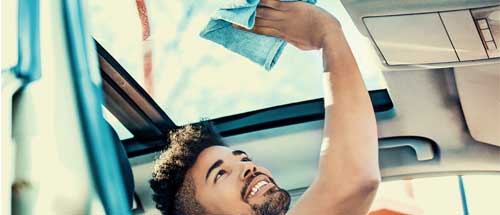
Other Things to Do
As well as these checks there are a few other things we advise you do before setting off on a long journey, including:
- Check the driver mode / profile
- Pack snacks and water
- Secure any loose items
- Set the satnav
- Turn your phone on do not disturb
- Check everyone's seatbelt is correctly fastened
What Should I Pack for a Long Trip?
Before going on a long journey you should make sure you have the necessary supplies, and we don’t just mean travel snacks though these may come in handy.
If your vehicle does not include a spare tyre then we recommend ensuring you have an inflation kit, in case you get a puncture on the trip. No matter which option you choose you need to make sure that it is functional, for a spare tyre this means in a good condition and at the correct pressure and for an inflation kit that it works.
We’d also advise keeping a warning triangle and high vis jacket in the car, if possible try and have one for each passenger.
There are other essentials you might want to keep in the car throughout the year but especially if you’re doing a long trip, such as a first aid kit, jumper cables and a few bottles of water in case of any emergencies.
Checking Your Car After a Long Journey
It's not just when you set off that you want to check your vehicle, when you reach your destination you should also be checking the condition of the vehicle.
When you first arrive you'll want to do a visual check, making sure that there is no obvious damage to the vehicle or areas of concern. If you are leaving the vehicle and have eaten in the car then we'd also recommend collecting any rubbish and removing it to dispose of.
We don't advise checking your tyres at this point but waiting a couple of hours allowing them to cool as hot air expands and so can give inaccurate measurements.
Then when the vehicle has been sat for at least eight hours you can then check the fluid levels and top up any as needed. It's important that you do not check the fluids any earlier, especially the engine coolant as this can get very hot and lead to serious injury if someone is caught by the steam.
How Regularly Should I Check My Car?
These checks are just the ones that you should do before a long trip, we recommend you check the condition of your vehicle regularly.
How frequently you should be checking your vehicle will depend on how often you use it and how many miles you're doing. For most drivers we'd recommend doing a comprehensive check similar to the one we've detailed above once a month but if you're driving a lot each day you might want to consider doing this every fortnight or even weekly.
For more information on looking after your car head back to our driver guides which look at taking care of your car, being a company driver, driving safety and much more.
